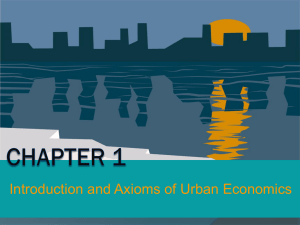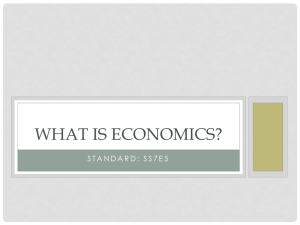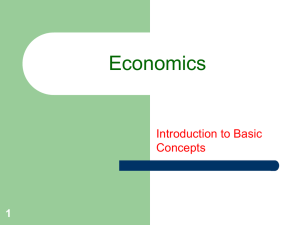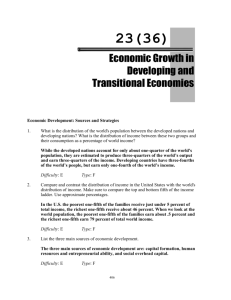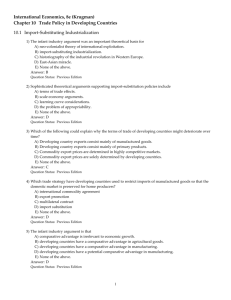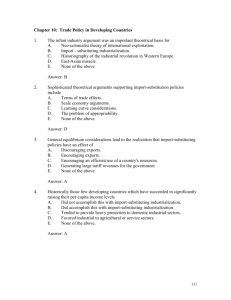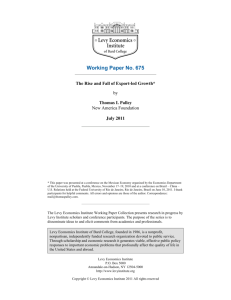Chapter 18 COMPARATIVE ECONOMICS
advertisement
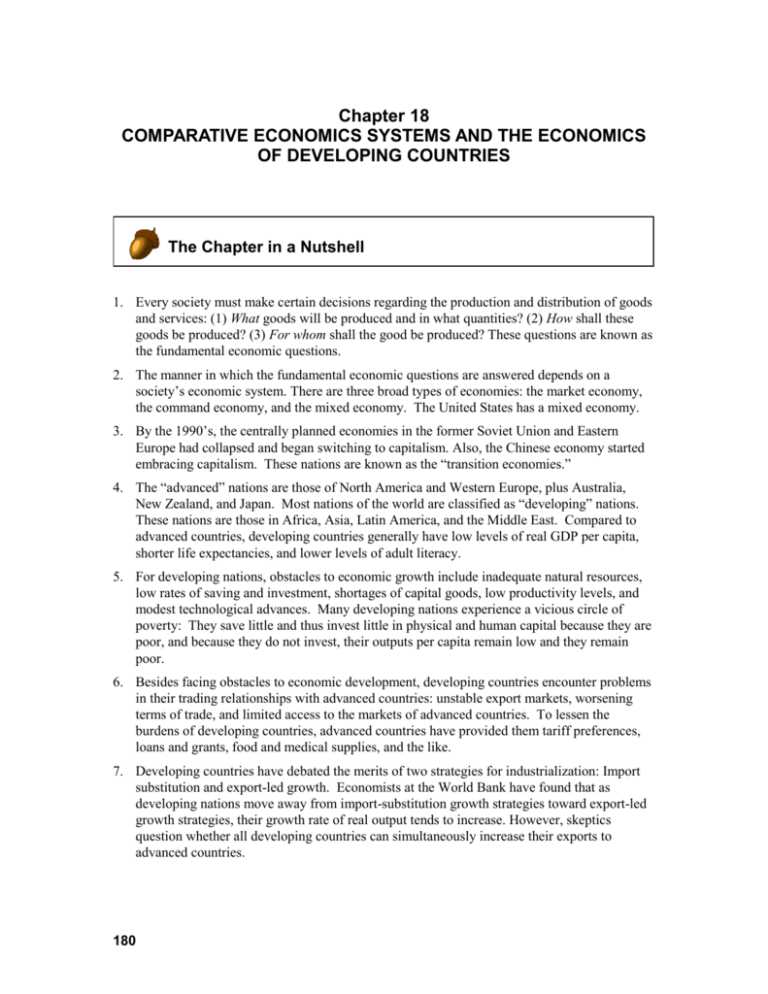
Chapter 18 COMPARATIVE ECONOMICS SYSTEMS AND THE ECONOMICS OF DEVELOPING COUNTRIES The Chapter in a Nutshell 1. Every society must make certain decisions regarding the production and distribution of goods and services: (1) What goods will be produced and in what quantities? (2) How shall these goods be produced? (3) For whom shall the good be produced? These questions are known as the fundamental economic questions. 2. The manner in which the fundamental economic questions are answered depends on a society’s economic system. There are three broad types of economies: the market economy, the command economy, and the mixed economy. The United States has a mixed economy. 3. By the 1990’s, the centrally planned economies in the former Soviet Union and Eastern Europe had collapsed and began switching to capitalism. Also, the Chinese economy started embracing capitalism. These nations are known as the “transition economies.” 4. The “advanced” nations are those of North America and Western Europe, plus Australia, New Zealand, and Japan. Most nations of the world are classified as “developing” nations. These nations are those in Africa, Asia, Latin America, and the Middle East. Compared to advanced countries, developing countries generally have low levels of real GDP per capita, shorter life expectancies, and lower levels of adult literacy. 5. For developing nations, obstacles to economic growth include inadequate natural resources, low rates of saving and investment, shortages of capital goods, low productivity levels, and modest technological advances. Many developing nations experience a vicious circle of poverty: They save little and thus invest little in physical and human capital because they are poor, and because they do not invest, their outputs per capita remain low and they remain poor. 6. Besides facing obstacles to economic development, developing countries encounter problems in their trading relationships with advanced countries: unstable export markets, worsening terms of trade, and limited access to the markets of advanced countries. To lessen the burdens of developing countries, advanced countries have provided them tariff preferences, loans and grants, food and medical supplies, and the like. 7. Developing countries have debated the merits of two strategies for industrialization: Import substitution and export-led growth. Economists at the World Bank have found that as developing nations move away from import-substitution growth strategies toward export-led growth strategies, their growth rate of real output tends to increase. However, skeptics question whether all developing countries can simultaneously increase their exports to advanced countries. 180 Chapter 18: Comparative Economic Systems and the Economics of Developing Countries Chapter Objectives After reading this chapter, you should be able to: 1. Discuss how a market economy, command economy, and mixed economy answer the socalled fundamental economic questions. 2. Explain why the transition economies began moving toward capitalism beginning in the 1990s. 3. Identify the obstacles to economic growth faced by developing nations. 4. Assess the economic growth strategies of developing countries. Knowledge Check Key Concept Quiz 1. fundamental economic questions 2. capitalism 3. laissez-faire economy 4. command economy 5. mixed economy 6. socialism 7. advanced nations 8. vicious circle of poverty 9. primary products 10. terms of trade 11. import substitution 12. export-led growth _____ a. is defined as the average price of a country’s exports divided by the average price of imports _____ b. include agricultural goods, raw materials and fuels _____ c. a system in which the government has a limited economic role _____ d. is the industrialization strategy that became popular in the 1950’s and 1960’s _____ e. a free enterprise system, rooted in private property ____ f. is practiced in economies like Sweden and Denmark _____ g. combine elements of both market and command _____ h. includes North American and Western European countries _____ i. an economy where the government makes all decisions concerning production and distribution _____ j. is experienced by many developing countries ______k. what, how and for whom ______l. is an outward-oriented growth strategy 181 182 Chapter 18: Comparative Economic Systems and the Economics of Developing Countries Multiple Choice Questions 1. The U.S. experienced sustained growth in the 1990’s due to a. b. c. d. freer trade deregulation global competition all of the above 2. For markets to work, rules of the game have to be specified in these areas a. b. c. d. bankruptcy contracts property rights all of the above 3. One of the reasons behind the failure of the Eastern European economies was a. b. c. d. price controls efficient public enterprises low barriers to competition none of the above 4. During a transitional period, many Eastern European countries attempted to combine economic decentralization with a. b. c. d. partial price decontrol perfect price control price fixation none of the above 5. In the late 1950’s, China departed from the Soviet model and shifted to a. b. c. d. large-scale capital intensive industry small-scale labor intensive industry linking individual reward to individual effort all of the above 6. In the 1970’s, China saw that Singapore, Taiwan, South Korea and Hong Kong a. b. c. d. enjoyed extraordinary growth and prosperity suffered huge economic setbacks were performing worse than China were suffering from severe price controls 7. China needs to institute reforms in the areas of a. b. c. d. restructuring state-owned enterprises state banks social security all of the above Chapter 18: Comparative Economic Systems and the Economics of Developing Countries 8. China’s economy may be characterized as a. b. c. d. dependent on foreign capital free of large public sector enterprises capitalist mostly export-oriented 9. Among major developing nations, China has a. b. c. d. the most amount of land the least amount of land more land than Singapore none of the above 10. The obstacles to economic development include, a. b. c. d. inadequate natural resources overpopulation shortage of capital all of the above 11. Developing nations’ exports are often concentrated in a. b. c. d. primary products manufacturing products human capital high-tech goods 12. Terms of trade is defined as a. b. c. d. export volume/import volume index of export prices/index of import prices import volume/export volume index of import prices/index of export prices 13. Monopoly power of manufactures in industrial nations results in a. b. c. d. lower prices stable prices higher prices none of the above 14. Strategies for development include a. b. c. d. import substitution export-led growth (a) and (b) none of the above 183 184 Chapter 18: Comparative Economic Systems and the Economics of Developing Countries 15. Taken together, the exports of all the world’s poor and middle-income countries equal only a. b. c. d. 5 percent of world output 50 percent of world output 28 percent of world output 10 percent of world output 16. All economic systems must answer fundamental economic questions which include all of the following except a. b. c. d. what goods will be produced and in what quantities? how shall goods be produced? for whom shall goods be produced? all of the above are fundamental economic questions 17. Which economic system is essentially a free-enterprise system, with minimal government intervention in the economy, that is rooted in private property and markets? a. b. c. d. market economy command economy socialistic economy mixed market economy 18. The economy of the former Soviet Union most closely approximated a a. b. c. d. command economy market economy mixed market economy socialistic economy 19. Developing economies tend to be characterized by all of the following except a. b. c. d. they emphasize the production of primary products their manufactured goods have limited access to the markets of industrial countries they realize relatively high levels of income per capita they have high rates of population growth 20. Which economic growth strategy involves extensive use of trade barriers to protect developing country industries from the rigors of foreign competition a. b. c. d. lower prices stable prices higher prices none of the above Chapter 18: Comparative Economic Systems and the Economics of Developing Countries 185 21. The _____is an international organization that provides loans to developing countries for projects such as hospitals, schools, and dams. a. b. c. d. World Bank International Monetary Fund NAFTA United States 22. To help some developing countries gain better access to their markets, industrialized nations have extended _____ to their exports a. value-added taxes b. national sales taxes c tariff preferences d. import quotas 23. All of the following are economically advanced countries except a. Switzerland b. Japan c. Canada d. India True-False Questions 1. T F Central planning was the primary method of organization in the former Soviet Union, and Eastern Europe, prior to 1990. 2. T F Cuba and North Korea no longer make use of central planning. 3. T F Central planning never created an elite class of government bureaucrats. 4. T F In a mixed economy, the most important decision mechanism is the market. 5. T F Denmark and Sweden are socialist economies. 6. T F World Bank economists agree that export-led growth strategies encourage inefficient firms. 7. T F Import substitution allows a developing nation to protect it’s manufacturers against foreign competitors. 8. T F Import-substitution is an outward looking strategy for growth. 9. T F The world’s poor face tariffs, that are, on average, roughly twice as high as those imposed on the non-poor. 10. T F Global protectionism is an advantage for the developing countries. 11. T F Compared with the advanced nations, the value of manufactured goods produced by developing nations is low. 12. T F Developing countries experience a vicious circle of poverty. 186 Chapter 18: Comparative Economic Systems and the Economics of Developing Countries 13. T F Worsening terms of trade has been a serious disadvantage to the industrialized world. 14. T F Institutional and cultural factors can hinder economic development. 15. T F Insufficient amounts of capital goods contribute to low levels of labor productivity. 16. T F None of the developing countries has been able to improve its economic conditions over time. 17. T F In the next decade, China will experience severe economic dislocation. 18. T F China became a member of the WTO in 2003. 19. T F In trade, China has never followed a pattern consistent with the principle of comparative advantage. 20. T F The economic policies pursued in Eastern European countries failed because they were unable to provide adequate incentives for producers to supply efficiently goods and services that consumers wanted. 21. T F Mixed market economies essentially constitute laissez-faire capitalism. 22. T F In a market economy, the questions what, how, and for whom to produce are determined by a system of prices and markets, with profits and losses. 23. T F A command economy, also termed communism, is one in which government makes all decisions concerning production and distribution. 24. T F Sweden and Denmark tend to embrace market economies as economic systems. 25. T F For developing countries, obstacles to economic growth include limited access to foreign markets. 26. T F Many developing countries save little and thus invest little in physical and human capital because they are poor. 27. T F In recent decades, China, South Korea, and Malaysia have primarily relied on import substitution policies to promote economic growth. 28. T F The World Bank is an international organization that primarily makes short term loans to developing countries experiencing financial crises. 29. T F All loans made by the International Monetary Fund are subject to conditionality, meaning that to obtain a loan a country must agree to implement economic policies as mandated by the IMF. 30. T F The United States has essentially a socialistic economy. Chapter 18: Comparative Economic Systems and the Economics of Developing Countries Answers to Knowledge Check Questions Key Concept Answers 1. k 7. h 2. e 8. j 3. c 9. b 4. i 10. a 5. g 11. d 6. f 12. l Multiple Choice Answers 1. d 5. b 2. d 6. a 3. a 7. d 4. a 8. a 9. 10. 11. 12. c d a b 13. c 14. c 15. a 16. d 17. 18. 19. 20. a a c a 21. 22. 23. a c d True-False Answers 1. T 6. F 2. F 7. T 3. F 8. F 4. T 9. T 5. T 10. F 11. 12. 13. 14. 15. T T F T T 16. 17. 18. 19. 20. 21. 22. 23. 24. 25. F T T F T 26. 27. 28. 29. 30. T F F T F F T F F T 187
